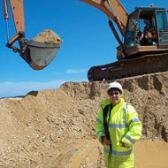Bestwall Quarry
Region: South West
Owner Type: Company
Funding Body: Aggregate Industries; Aggregate Levy Sustainability Fund
Year of Intervention: 1992 - 2004
Summary: Bestwall Quarry- site of a major Anglo-Saxon industry is recognised by radiocarbon dating, which was otherwise archaeologically invisible due to lack of artefacts.
Description: Excavations by local volunteers at this 55 hectare gravel quarry have uncovered a multi-period landscape during a 12 year 'rescue' archaeology project. Features date from the late Mesolithic to the post-medieval period and comprise field systems, droveways, working areas, domestic structures, pit clusters, industrial activity, burials, and ritual deposits. The best represented periods are the middle Bronze Age, late Bronze Age, and Roman.
Issue: About 850 pits containing large amounts of charcoal were found all over the quarry site. The vast majority of these pits contained no datable finds, although such artefacts as were present suggested that these pits spanned several thousand years. The charcoal identification revealed that almost all the material was oak, with a small amount of holly. Four iron-working surfaces together with three substantial spreads of iron working debris (slag) were also excavated. These were thought to be Roman on the basis of the pottery and the type of furnaces present.
Strategy: A substantial number of radiocarbon dates from these features demonstrate that this activity is of middle Saxon date (around 650–900 AD). There seems to have been widespread charcoal burning at Bestwall to provide fuel for the iron-working activity.
Outcome: This study shows that radiocarbon dating must be seen as a critical element in the interpretation of post-Roman/Saxon archaeology, particularly in parts of the country where artefactual material of this date is difficult to identify or otherwise absent.
Keywords: Research & Archives, Social Inclusion & Access, Sustainability
Web Links:
© English Heritage

